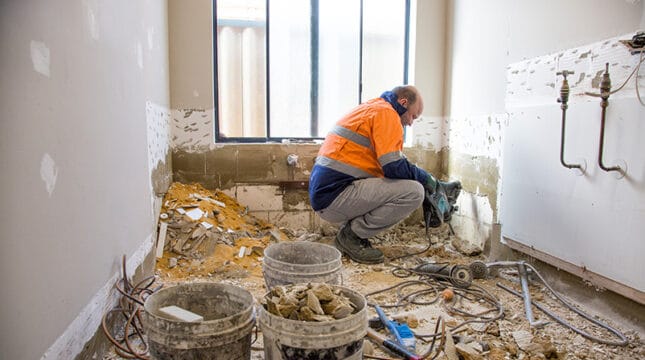What is commercial flood insurance?
Commercial flood insurance is a type of policy that can help small businesses recover after a water deluge. It can help provide the resources for property owners to rebuild damaged building structures, replace inventory or repair or repurchase wrecked business gear.
Evaluate your business’ flood risk and mitigate it with flood insurance from the Federal Emergency Management Agency (FEMA) National Flood Insurance Program (NFIP) program, a private insurer or both.
NFIP offers two types of insurance:
- Up to $500,000 in building coverage (the structure itself).
- Up to $500,000 in building contents coverage insurance (business personal property).
You can buy a flood insurance policy from an insurance company or insurance agents and brokers who distribute NFIB policies. If your building and contents are worth more than $500,000, you can purchase excess coverage from a private insurer.
How much is commercial flood insurance?
There’s no set price for commercial flood insurance. What you pay will depend on factors such as your:
- FEMA flood map status.
- Construction design and materials.
- Building size.
- Property value.
- Building age.
- Type of flood coverage (building and contents; building or contents only).
- Elevation.
- Presence of basement or crawlspace.
- Proximity to natural sources of water (rivers, streams or lakes).
- Previous flood incidents at your location.
Your monthly or annual premium will vary depending on the specifics of your building, your business and your geographic area.
Do I need business flood insurance?
Wherever rain falls, a flood is possible. This means virtually every small business is at risk.
State and federal authorities determine whether you must buy flood insurance. If your commercial building is in a high-risk flood zone and your mortgage is from a federally-insured or regulated loan provider, it’s more likely you’re going to need to buy flood insurance.
Hundreds of U.S. communities have suffered flood incidents, including Los Angeles, California and Montpelier, Vermont.
In 2023, after a record-breaking rainfall in New York City over 24 hours, Brooklyn experienced overflowing sewer drains and floating debris. More than 130 businesses experienced severe flooding. In the Park Slope area, 30 businesses experienced severe damage — some had six feet of water in their basements which destroyed valuable inventory and equipment.
Here’s why it could be essential to insure your small business against flooding:
- Since 1996, floods have afflicted 99% of U.S. counties. It’s harmed the livelihood of hundreds of thousands of small business owners — some multiple times.
- From 2011- 2015, the average commercial flood claim was close to $90,000. Would it be difficult for your business to pay that out of pocket?
- FEMA may not bail you out with a disaster grant. They’re usually only available to small business owners who fail to qualify for a U.S. Small Business Administration (SBA) low-interest disaster loan.
- Businesses located outside a federally designated flood zone aren’t safe from flooding. According to FEMA, 40% of flood damage claims result from floods in low-risk areas.
If you’re considering buying a business property, research its flood risk:
Even if it’s not a high-risk property, FEMA suggests flood insurance anyway. Lower-risk properties account for more than 25% of FEMA flood claims and receive one-third of federal disaster assistance.
And if you rent space in a commercial property — even if your landlord buys flood insurance for the building — you may still want to protect your property against invasive water.
What does flood insurance for business cover?
NFIP flood insurance covers damage to commercial properties and the contents of buildings due to:
- Overflowing rivers and streams.
- Heavy rainfall.
- Storm surges.
- Melting snow.
- Collapsed or leaking dams or levees.
- Mold or mildew after a flood.
NFIP insurance activates only if a flood affects at least two acres of land and two properties or more.
NFIP flood insurance for commercial buildings covers:
- A building’s structure and foundation.
- Staircases.
- Building systems such as electrical, plumbing, HVAC and fire protection.
- Appliances.
- Permanently installed carpets.
- Permanently attached structures such as awnings and canopies, paneling, bookcases and cabinets.
- Windows.
- Tanks and pumps.
- Furniture, machinery and equipment used in the business.
- Products for sale (finished inventory, raw materials or work in process).
NFIP flood insurance for building contents covers:
- Personal property such as furniture, framed art and curtains.
- Portable and window air conditioners.
- Rugs (not permanently installed).
- Any other business property.
Flood insurance does not cover:
Does business insurance cover flood damage?
Commercial property insurance, a common type of coverage for small business owners, does not apply to floods. It may help protect some losses from falling water and certain types of water damage, but not from water flowing on or below the earth’s surface.
It does, however, cover damage caused by a faulty water main or burst pipe.
For example, if the pipes in Sam’s clothing store burst and flood his inventory, commercial property insurance could help cover the damage to his inventory, contents and store interior.
However, if heavy rains cause a river near Sam’s store to overflow and flood his commercial space, commercial flood insurance could help pay for the damage and repair or replacement of his building and contents.
BOP insurance (a business owner’s policy which combines commercial property insurance with general liability insurance) also won’t cover a flood loss.









